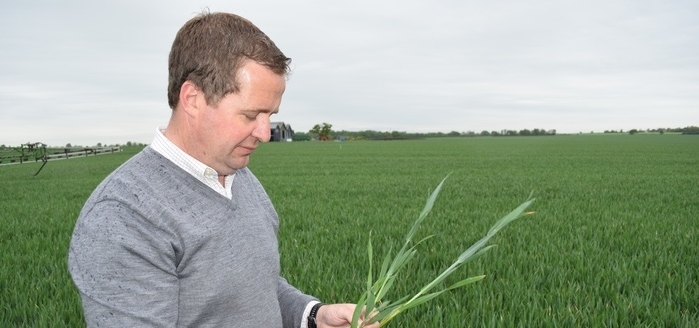- Liquid fertilisers at risk of ammonia volatilisation in current dry conditions
- Limus Clear is a risk management tool to be tank-mixed with liquid fertilisers when the risk of nitrogen losses from volatilisation is high
- Three ADAS Agronomics trials show an average yield benefit of +0.24t/hDry conditions are well known to increase the risk of nitrogen losses from granular urea but perhaps less widely acknowledged is the risk for liquid fertilisers. For over a decade, granular urea users have been able to switch to a urea fertiliser product treated with a urease inhibitor, to reduce such losses. With the introduction of a new urease inhibitor from BASF, liquid fertiliser users now also have the opportunity to better manage this risk, according to Richard Corden from BASF.“Liquid fertilisers e.g. UAN, are an excellent source of nitrogen, allowing accurate application and improved workload efficiency. However, it is often not fully understood that nitrogen can be lost after application. Up to half of the nitrogen in UAN is derived from urea. As the urea component is converted to plant available ammonium, it is subject to ammonia volatilisation, unless sufficiently washed into the soil.He adds: “ADAS led a project to evaluate ammonia volatilisation losses from UAN over a 3-year period and found that nitrogen losses due to volatilisation ranged from 5.5% to 19%.”
Certain environmental conditions, many of which are currently relevant for much of the country, can increase the risk of ammonia losses, including:
- Low rainfall: To minimise volatilisation, more than 10mm of rainfall is required within two days of application to wash the nitrogen into the soil
- Dry or drying soil surface: This reduces the diffusion of the nitrogen away from the soil surface
- Warm soil temperatures or high soil pH: This speeds up the conversion process resulting in greater losses
“Fortunately, these risks can be managed, and losses reduced by adding Limus Clear to liquid fertilisers,” notes Mr Corden.
Managing the risk with Limus Clear
Limus Clear is a new product to the market, available exclusively from Frontier Agriculture and designed specifically for liquid fertilisers. Extensive field trials carried out by BASF have demonstrated that Limus Clear reduces ammonia emissions from urea by up to 98%, minimising nitrogen losses and improving nitrogen use efficiency (NUE).
Ed Downing, Frontier’s National Crop Nutrition Technical Manager notes: “Nitrogen use effiency is always important, but given the challenging season we’ve had so far, it is perhaps even more so. The high over-winter losses of nitrogen have left very little in the soil, meaning we’ll be even more reliant on applied nitrogen than usual to feed our crops.”
“Limus Clear is fully compatible with all liquid fertilisers, both straight N and NS grades, is easy to use and low cost” he adds. “A low rate of Limus Clear, typically less than 0.2 l/ha (specific for each liquid grade), costing £2 – 4/ha, is mixed in with the liquid fertiliser during sprayer filling. This makes it an excellent risk management tool. When soils are moist and sufficient rainfall is shortly expected i.e. low risk, you wouldn’t include it. However, if no rainfall is forecast and there’s little or no canopy cover, resulting in fast-drying, bare soil, you would definitely use it,” Mr Downing adds.
This sentiment is echoed by Essex farmer, James Faulkner, who farms 1350ha at Peldon in Essex. He took part in one of three ADAS managed Agronomics, field scale trials on wheat crops last year, in which he added Limus Clear to his final two UAN applications.
Mr Faulkner noted how the small pack size made it a flexible product to take with him when he is operating the sprayer: “It has a low dose rate and it is an easy product to carry with you on the sprayer, so you can decide whether to add to the tank or not, depending on the weather conditions at the time.”
ADAS Agronomics trials show yield and economic benefit
Like many farmers, Mr Faulkner has switched from solid fertiliser to UAN in recent years. James invited BASF and ADAS to run a tramline trial after seeing Limus Clear perform well in Frontier trials, and was pleasantly surprised with the results.
“It didn’t seem like the type of season that Limus Clear would have big effects. The UAN went on as a split application in April and there were rainfall events soon after both applications,” he recalls. However, the results told a different story.
“The average yield of the farm standard crop was 12.78 t/ha. The modelled effect of the Limus Clear treatment, using the ADAS Agronomics methodology, was an increase in yield of 0.29 t/ha and an improved margin over input costs of £36.15/ha,”he concludes.
New liquid fertiliser urease inhibitor reduces nitrogen loss whilst improving plant nitrogen uptake
Share this story:




